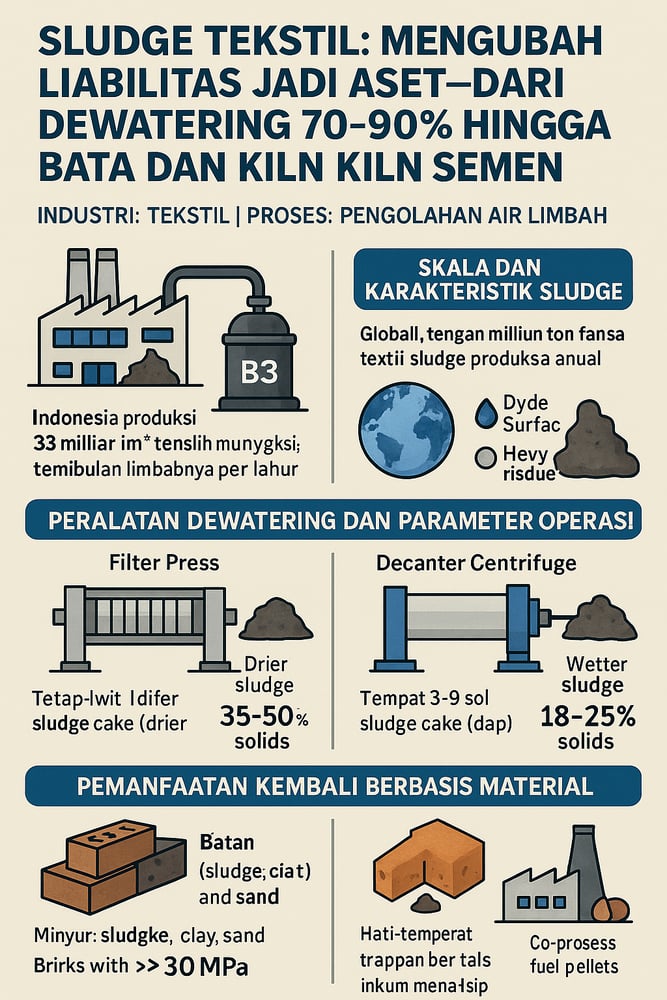Textile wastewater treatment plants are learning to dewater smarter—using filter presses at 5–15 bar and high‑RPM centrifuges—to cut sludge volume by 70–90% and slash hauling costs. What happens next depends on chemistry and regulation: licensed disposal, cement kilns, or reuse routes that now include 30.4 MPa fired bricks and 12.8 MJ/kg fuel pellets.
Industry: Textile | Process: Wastewater_Treatment
Textile wet‑processing doesn’t just make fabrics; it churns out sludge—mixed chemical and biological solids—by the tonne. In Indonesia alone, textile production of about 33 Mt/yr is linked to roughly 2–2.3 million tonnes of waste annually (news.okezone.com) (bsn.go.id). Globally, the footprint runs to the tens of millions of tonnes each year; one estimate pegs ~92 Mt from ~100 billion garments (www.scielo.br).
Much of that sludge is contaminated with dyes, surfactants, and heavy metals such as chromium (Cr), copper (Cu), and zinc (Zn), which often pushes it into “B3” status (hazardous waste) under Indonesian law (unair.ac.id) (link.springer.com). Untreated sludge raises environmental and health risks, including metal leachate (link.springer.com) (unair.ac.id). In practice, textile plants typically collect and process their sludge on‑site.
Sludge characteristics and status
Textile sludge is a composite of biological solids and process chemicals. The “B3” designation (Indonesian hazardous classification) hinges on constituents like metals from dyeing; the status dictates handling and disposal pathways (unair.ac.id) (link.springer.com). The global scale—tens of millions of tonnes annually, including a cited ~92 Mt tied to ~100 billion garments—underscores why standardized management is now non‑negotiable (www.scielo.br).
Baca juga: Cara Efektif Menjaga Semen Tetap Kering: Silo Kedap, Udara Kering, dan Additive Hidrofobik
Mechanical dewatering methods
Sludge dewatering is the volume‑reduction workhorse. Filter presses—plate‑and‑frame systems that compress sludge between filter plates—apply high hydraulic pressures, commonly 5–15 bar, to squeeze water into filtrate and leave a dense “cake” (solid fraction) (www.lenntech.com). Well‑operated presses routinely produce cakes above ~35–50% solids (www.hcr-llc.com) (www.lenntech.com).
Decanter centrifuges (solid‑bowl scroll centrifuges) spin continuously at high RPM so denser solids migrate outward. The trade‑off: excellent throughput and continuous operation, but wetter cakes—typically ~18–25% solids (~75–82% moisture)—and higher energy demand, versus the drier, batch‑mode filter press (www.hcr-llc.com) (www.lenntech.com). One treatment plant reported that adding decanter centrifuges raised dry solids by ~20%, lowering disposal costs (www.waterandwastewater.com).
Pneumatic or screw presses (not shown) and gravity belt thickeners are often used upstream for bulk dewatering prior to a filter press or centrifuge. Chemical conditioning—typically polymers (flocculants) or coagulants to promote rapid floc formation—is often required to hit high capture and drainage rates (www.lenntech.com) (www.hcr-llc.com). Plants commonly deliver these reagents via precise chemical metering using a dosing pump, pairing flocculants with coagulants to tune performance. Overall, mechanical dewatering typically reduces sludge volume by 70–90% by weight, sharply cutting hauling costs (www.lenntech.com) (www.hcr-llc.com).
Regulatory disposal pathways

Final handling hinges on chemistry and regulatory status. In Indonesia, sludge classified as B3 must go to licensed hazardous waste facilities or be immobilized/incinerated (unair.ac.id). Incineration or co‑processing (using another industry’s thermal unit) is feasible when metals are effectively contained. For instance, partial drying and pelletizing—often blending textile sludge with biomass like cattle manure—can yield a 75:25 cattle:textile pellet at ~12.8 MJ/kg calorific value, with about 42–44% of the mass remaining as ash; critically, combustion conditions fixed heavy metals in the ash below regulatory limits (pubs.acs.org).
Cement kilns are another route: the high‑temperature, alkaline atmosphere neutralizes acid gases such as SO₂ and HCl and traps >90% of heavy metals in clinker, with studies showing minimal air emissions of metals (except Hg/Tl) during co‑processing of sewage/textile sludge (www.scirp.org). By contrast, open dumping or simple landfilling of untreated sludge would violate Indonesian B3 rules and heighten leachate risk (unair.ac.id).
Baca juga: Panduan Maintenance Sistem Pneumatik di Area Packaging Pabrik Semen
Beneficial reuse routes
Non‑hazardous fractions or stabilized sludge open reuse options. A well‑studied path is brickmaking: mixing dewatered textile sludge into clay‑sand mixes—commonly up to ~10–15% by weight—followed by firing can produce bricks that meet strength standards. One study reports bricks with 10% textile sludge at 1200 °C delivering ~30.4 MPa compressive strength (megapascals, a pressure/strength unit) versus ~32.3 MPa for pure clay bricks, with acceptable water absorption (link.springer.com). Another found 15% sludge bricks exceeding 3.5 N/mm² (a common design threshold) (www.researchgate.net). Replacing some clay with sludge can also save firing energy—on the order of ~25–50% (link.springer.com).
Sludge can similarly substitute raw materials in cement or concrete (as fillers or mineralizers) when metal content is low. Agricultural reuse or landspreading is a niche option, but high metal/toxin levels typically contraindicate this. Stabilized/solidified sludge (e.g., mixed with cement or clays) can be used as roadbase or landfill cover. In all scenarios, Indonesian regulations—PP No. 22/2021 and KLHK guidelines—require meeting safety criteria, including leachability limits (unair.ac.id).
What plants implement in practice
Most textile effluent treatment plants combine thickening with either a belt system or a filter press to sharply cut sludge volume—often 70–90% by weight—before deciding on disposal or reuse (www.lenntech.com) (www.hcr-llc.com). The data points are now familiar: centrifuges boosting cake solids by ~20% in one case (www.waterandwastewater.com), cement‑sludge bricks achieving >30 MPa strength (link.springer.com) (www.researchgate.net), and energy‑recovery briquettes meeting fuel specs at ~12.8 MJ/kg while keeping metals below limits in the ash (pubs.acs.org). For Indonesia’s 2–2.3 million tonnes of textile waste a year, these moves help turn a liability into a resource—while staying within B3 rules (unair.ac.id) (news.okezone.com).
